Visual effects supervisor Chris Godfrey describes The Great Gatsby as “by far the biggest and most complex” film he’s worked on. Having collaborated with director Baz Luhrmann on films such as Australia and Moulin Rouge, Godfrey attributes most of the complexity to just how close the camera comes to fully CG buildings and environments to help tell the story of the millionaire Jay Gatsby in and around 1920s New York.
In this article we take a look at the major contribution of principal effects vendor Animal Logic to Gatsby. Their work formed the bulk of 1449 shots in the film, with additional contributions from an in-house ‘S.W.A.T’ effects group, Prime Focus Vancouver, Rising Sun Pictures, Iloura, ILM and Method Vancouver.
Click here to see a breakdown reel of Animal Logic’s work for the film.
VFX prep and shooting
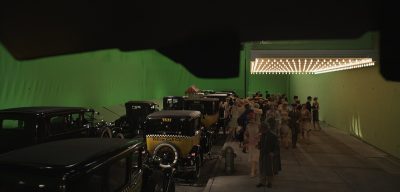
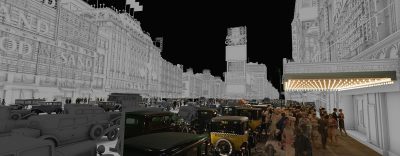
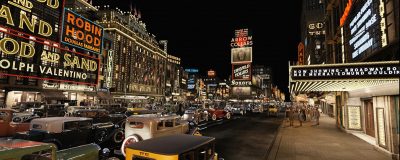
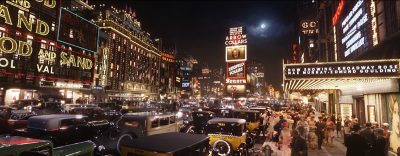
A significant previs and techvis effort was part of the visual effects team’s responsibilities. The internal S.W.A.T. team also managed the workflow of VFX shots – which were completed in stereo – throughout production. “We had our own laboratory,” outlines the film’s visual effects producer Prue Fletcher. “We ran a Mistika out of there and everyday we ran rushes. We did a geo fix on everything and the left and right eye and checked all of those. We also sent out a Nuke script with every shot so Chris had the color balance and color time set back in.”
Gatsby was shot on RED EPICs in native stereo with the 3Ality rig. Chris Godfrey made heavy use of metadata from the cameras, lenses and the rig to help with VFX shot preparation. In addition, LIDAR scans, witness cameras and a dual camera filming the main one was employed. “I also got Panavision to make me an offset plate,” says Godfrey, “so we had our own RED EPIC in the VFX department – a single camera not a dual stereo. We put that on the offset plate and that had a motorised head that traveled from left to right or right to left over a period of time. It meant then we could go into any set and go left eye/red eye and pick an eye and a variable IA or where the camera was sitting, depending on where the camera actually went. There was a seven and a half inch offset so it also gave us the opportunity on occasions to do geo with it as well – we could also build sets out of it. It gave you enough information about where your depth plains were.”
“The other thing we used it for,” adds Godfrey, “which was really helpful was, even up to eight days before we finished, I actually did a shoot with stills. There’s a section where newspapers come flying down, one newspaper over the other. That was a late idea and I actually shot that with a Canon stills camera with this offset plate. We shot 15 newspapers dropping down. We would build the set and dismantled it and every time we dismantled it I’d shoot a left eye and bracket it and then a right eye and bracket it. So that shot was actually a single camera shooting 60 stills.”
For Animal Logic, Gatsby was their first major live action pic shot natively in stereo. “One of our biggest concerns at the beginning was tracking,” states Animal’s visual effects supervisor Andy Brown. “The data team that Chris had on set was great – they LIDAR’d all the key sets. Then Felix Pomeranz did Leica Total Station surveys of all the small sets and greenscreen sets. We had witness cameras going and would shoot 360 stills, which helped us track all the plates in 3D Equalizer to make sure we had low res tracking models to track to so that both eyes would track properly.”
“That really helped us,” adds Ingrid Johnston, Animal Logic’s visual effects producer. “In the few situations where we didn’t have all the survey data it was a bit hit in the dark as to what the stereo should really look like, but most of it came through really well. And moving through the pipeline it didn’t have too much of an impact on what we were doing.”
New York environments
The Great Gatsby takes place in the ‘roaring 20s’ and features a number of New York locations that would be created and fleshed out by the visual effects teams. “When you look around New York there’s so little of that left,” acknowledges Godfrey, “and there would be so much fix up and so much generation of other bits and pieces. You can’t even get on the Queensboro Bridge with the barriers down the center, so you wouldn’t be able to shoot on there. In the older films you couldn’t actually film it and show it – but we could actually do these.”
Animal Logic was tasked with several city builds reflecting the era. The team looked to concept art and designs from production designer Catherine Martin and also particular materials. “There was one book called Mythic City,” says Brown, “with a series of photographs by a guy called Samuel Gottscho. He took these amazing shots in the 1930s when they were building buildings like the Rockefeller Center. There’s also a lot of shots of Queensboro Bridge as well.”
“Also,” adds Ingrid Johnston, Animal Logic’s visual effects producer, “a great historical researcher was attached to the film who provided a lot of historical reference of photos that would normally be quite hard to find. And there was also the basis of a map of all of New York at the time, how much of the streets were built up, what areas were built earlier or later. So to build New York, we built out a low-res version that we could easily manipulate and then add areas in with detail that we spent a lot of time in.”
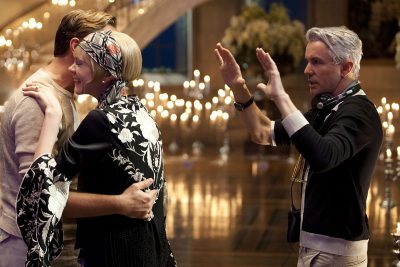
Animal divided New York into different sets, then created full CG builds. “We built about 20 buildings and then re-dressed them with different windows and also there’s lots of different signs, broken furniture and junk in the streets, CG extras cars,” explains Brown. Large pull-out shots, such as one from the Queensboro Bridge, were realized as a combination hi-res build and increasingly lower-res structures as the camera zooms out, with two and a half D matte paintings.
A Times Square shot made use also of many signs and neon lights. “All the individual lights were all modeled,” says Brown. “Animation-wise, we color-coded them so each bulb would have a different color and then we’d space them out – red, green, blue, magenta – so we’d figure out the animation say clockwise and we’d sequence the color around the edge of the border. That scene has a lot of crowds in it too – all done in Massive with lots of people going to the theatres – CG cars, crowds, taxis. The live action elements were shot against greenscreen with a minimal set.”
The highline
Car sequences involving Gatsby’s Duesenberg made use of a combination of live action photography, CG cars, digital crowds and drivers and generated environments. For reference of the final look for a chase sequence, Luhrmann had Animal Logic watch the 1928 film Speedy starring Harold Lloyd which featured a ‘weaving through the New York streets’ car pursuit. “We used that as reference to show how chaotic the streets were,” says Brown. “There were also some nice establishing shots of New York back then.”
See parts of the highline sequence and many other VFX shots in the film’s trailer.The Duesenberg sequence was firstly previs’d, with live action wide shots filmed against a massive greenscreen wall at a disused dock at White Bay in Sydney. The green wall was made of plywood with a scaffold backing and ran about 200 meters. The actors were filmed inside a Duesenberg replica against greenscreen with an interactive lighting setup, but ultimately the stand-in car was mostly replaced with a CG version to properly deal with reflections.
“In the end, the Duesenberg car was almost like a mirror,” notes Brown. “It was reflecting all the lights and the camera rig into all the chrome areas of the car. So at the beginning of the job we thought it would just be adding reflections to the body of the car, but in the end for most shots we replaced the Duesenberg with our CG car.”
Making a mansion
Gatsby’s mansion became a combination of many elements that visual effects helped tie together. “The front street was shot at Centennial Park in Sydney,” says Godfrey. “The front of the mansion was shot at Manly (a seaside Sydney location). The hallway and the ballroom and dance area was shot in Stage 1 (at Fox Studios). Stairs down to the pool shot in Stage 2. The beach was shot at Doll’s Point (another Sydney locale). The wharf was shot in stages 1 and 3. Nick’s bungalow next door was shot in 3, 1, Mt Wilson (west of Sydney) and Centennial Park.”
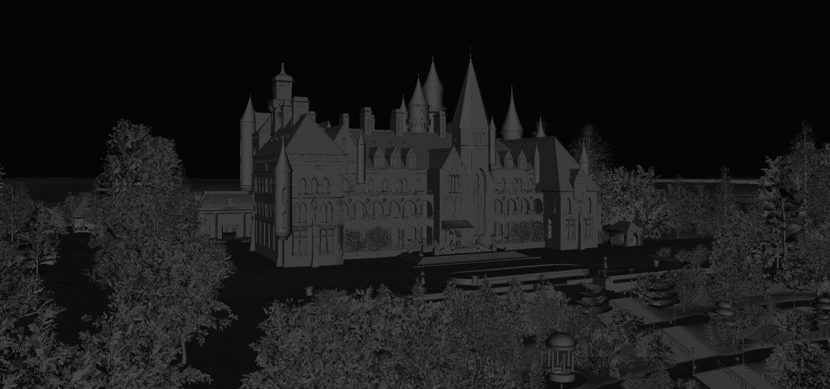
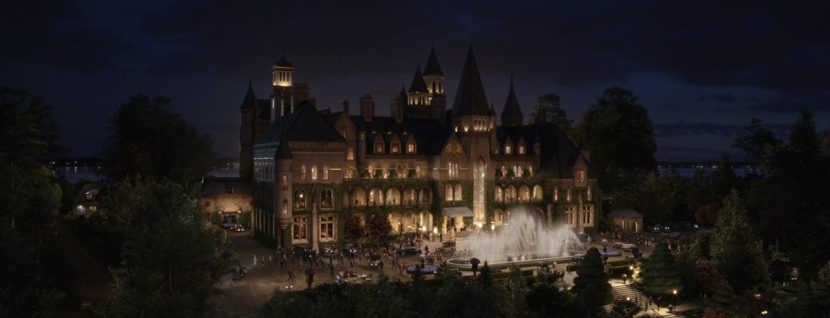
“Gatsby’s house is based on a old house, Beacon Towers,” says Brown, “which has these turrets and then he wanted to mix it with the current idea of say a Russian Oligarch having owned it – lots of gold trims. So the organ’s made of solid gold and has lots of fan pipes coming out of it. The carpet itself has Gatsby’s monograph imprinted. Things like the garden – Gatsby’s gardens were all very exotic while Nick’s mansion which is old money on the other side of the bay – it was more classical and minimal with neat hedges.”
“Chris had LIDAR scans of each of the shot locations and sets,” continues Brown, “so we could model and stitch everything together so it would match Baz’s original layout. Once we had all the set stitched together, we could elevation models from the real location, model the terrain from that and take it from there.”
Bringing style to Gatsby
The Great Gatsby has enjoyed an incredibly successful run since opening in the US on May 10th. The film brings Baz Luhrmann and Catherine Martin’s unique and somewhat stylized stamp to the much-loved novel. “Baz never wanted to do the romantic King Kong look – brown. The reality is, everything was brown! So we pumped the colors. The hyper-reality of the original colors was a post-grade,” reflects Chris Godfrey, who paid tribute to the VFX vendors and his producer Prue Fletcher in managing the effort.
All images and clips copyright 2013 Warner Bros. Pictures.

As for Prime Focus’ work, there is also a VFX breakdown on Vimeo : https://vimeo.com/67661844 🙂
http://wiki-fx.net/pages/the-great-gatsby/
Pingback: The Great Gatsby VFX Before and After Shots by Animal Logic